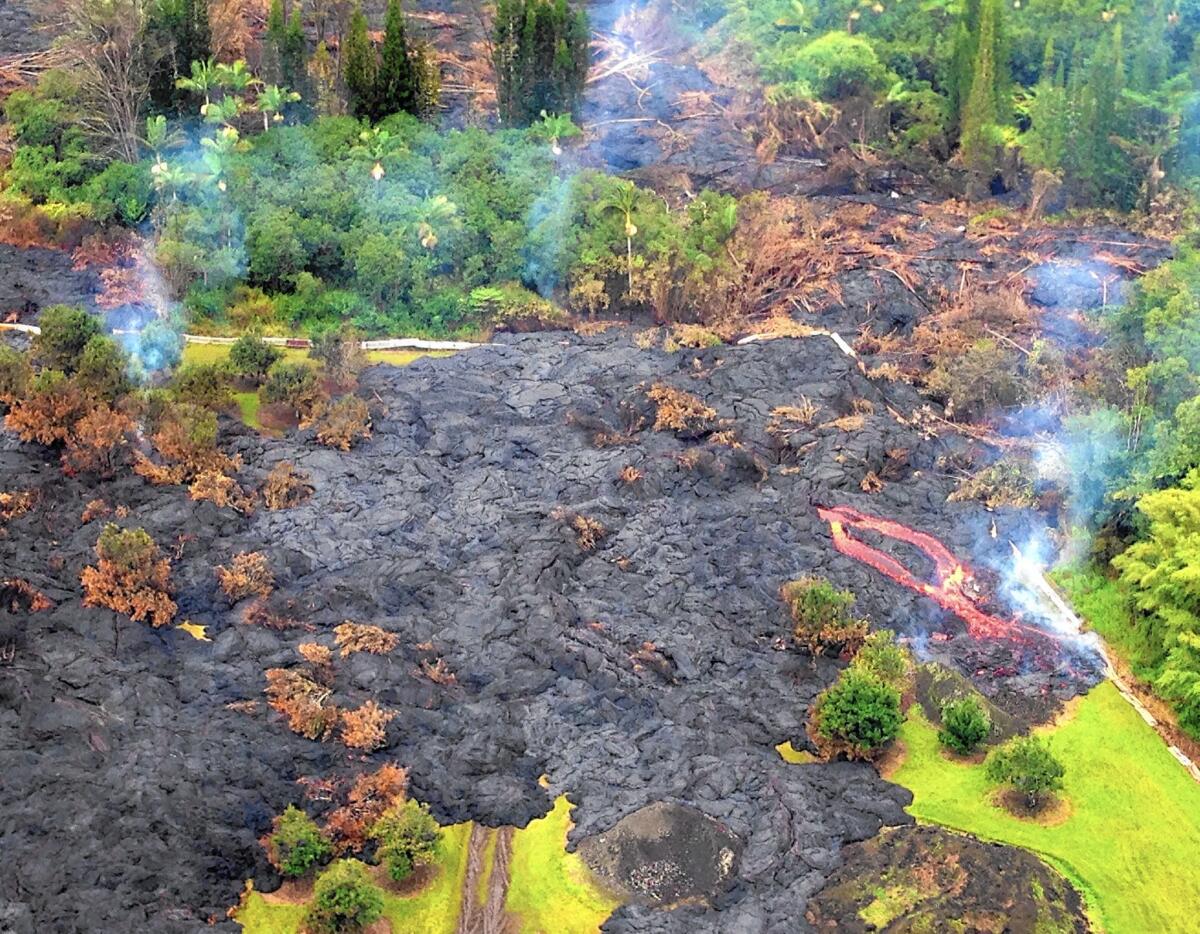Hawaiian is philosophical about lava after years of going with the flow

- Share via
Reporting from KALAPANA, Hawaii — On an overcast Monday afternoon, Aku Hauanio is seated on a picnic table in front of his Uncle Robert’s house — one of the few structures in town spared 25 years ago by Kilauea, one of the most active volcanoes in the world.
A red cinder trail leads from the heart of this small enclave through a plain of billowing, rock-hard pahoehoe lava to the ocean. Ferns grow in deep crevasses. Coconuts brought by visitors have sprouted and struggle to grow in the inhospitable ground. Waves crash.
Hauanio remembers his verdant, pre-volcano beach town on the east end of the Island of Hawaii as “just one of the beautifulest places on the island. So beautiful it’s hard to explain. Everything was like plentiful down here. Fish, fruits, everything. Not much people, just a couple Hawaiian families lived down here.”
He often refers to the lava flow as “da ting,” as in, “Da ting just came down all over here.” He watched it in 1991 as it devoured the house where he was born and raised and where his father still lived when the lava made its gradual way to the coast.
He remembers being a 2 a.m. spectator as the molten flow entered the house through the back, took down the water tank and set the modest structure ablaze.
The U.S. Geological Survey documented the eruption of Kilauea and the lava’s fierce path through 180 homes in Kalapana: “Slow-moving pahoehoe lava gradually spread through the community,” the agency reported, “burning homes and covering parks, roads and gardens.”
A generation later and 12 miles up the road lies Pahoa, in whose general direction Kilauea has now directed its molten wrath. An oozing, burning plume has been advancing toward the town of 950 residents from the volcano’s east rift zone since June, claiming its first home on Nov. 10 and threatening to cleave the eccentric enclave in two.
The lava moves in fits and starts, advancing for a few days, then stalling for weeks. Pahoa’s supermarket and drugstore shut down in December when it seemed the flow was nearing. But then it stopped. The drugstore reopened. Other retailers are preparing to do the same.
What to do? Hauanio and others still living down the road in Kalapana already know the answer: Wait. Watch. Then move.
When his father’s house was burned by the lava that night in 1991, Hauanio, 62, a former Hawaii Volcanoes National Park employee, remembers watching in stunned amazement with his former wife. “We just was like, ‘Wow.’ And then we went home,” he said.
Much of the town already was a crisp, black moonscape of hardened lava. But Hauanio was determined to stay.
His own house was safe for the moment, but Hauanio was resigned to the fact that it would be next to go. His children, however, weren’t. They begged him to move the structure to secure ground, the way parishioners had relocated the nearby Star of the Sea Catholic church months earlier.
He persuaded a friend with a bulldozer to widen the narrow approach to his threatened house. He hired a crew with a strong lowboy trailer. A week after his childhood home burned, he rolled his current house two miles up the road.
The lava arrived the next day.
The lava, he said, “flows like water, but it’s not. Everything’s burning. There’s a lot of crackling. You no can hear bubbles [of lava] popping, but you can see ‘em. It’s just like a big pond.”
Kalapana was once home to a famous black sand beach and a historic Hawaiian village. It is now a perfect geological specimen of pahoehoe.
There are two main kinds of lava: pahoehoe and aa. The latter, said Janet Babb, a geologist with the USGS Hawaiian Volcano Observatory, is “jagged and rubbly” and can be found high on the slope above Kalapana.
The lava that covers the beach here is an outdoor pahoehoe exhibit worthy of a natural history museum. There are many variations, Babb said — “ropy, wrinkled, billowy, slabby, sticky, glassy” — and most all of them are to be found here on the southeast edge of the Big Island.
There are pillowed stretches broken by what Babb describes as the flow’s inflation. “Think about how the surface of a cream puff cracks if you insert too much cream in the center: same idea with the lava flow.”
And there are vast lengths of perfectly twisted lava ropes, shiny swirls with an angry beauty. The ropes are formed when the lava’s crust begins to harden but molten rock below is still moving, pushing the solidifying top into wrinkles, much like a spatula pushing scrambled eggs in a pan.
Today, Kalapana is lovely in its own way, said Hauanio, who still lives in the house he rescued from the flow a quarter of a century ago.
When he thinks about the on-again, off-again threat to Pahoa, he is philosophical. If you live in Pahoa, he said, you always have to be ready to move.
“The whole island is made out of lava, yeah?” he said. “You cannot do anything. You cannot cry. When the lava comes, you just gotta take what’s important to you and just move out of the way.”
Twitter: @marialaganga
More to Read
Sign up for Essential California
The most important California stories and recommendations in your inbox every morning.
You may occasionally receive promotional content from the Los Angeles Times.














